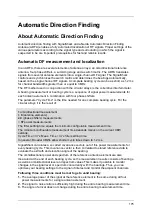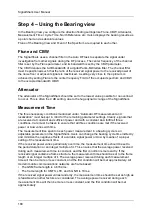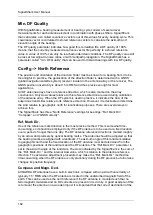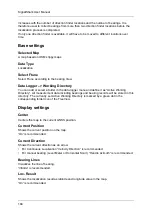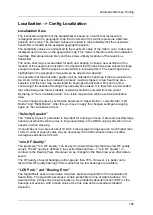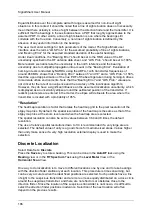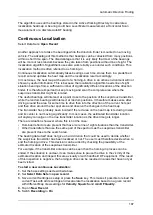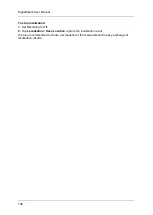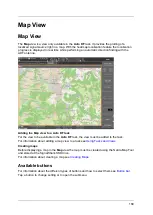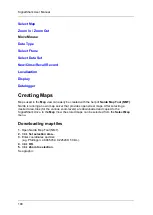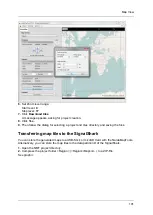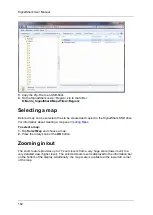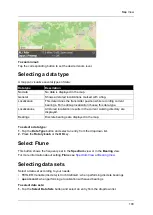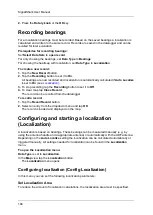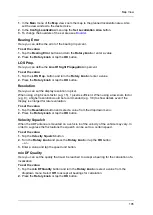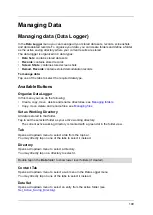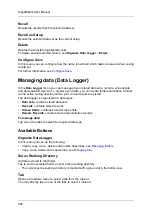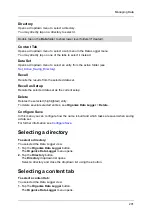
Automatic Direction Finding
187
The algorithm uses all the bearings stored in the Active Working Directory to calculate a
localization heatmap. A bearing could be a Level Meter measurement, a Horizontal Scan
measurement or a discrete AutoDF bearing.
Continuous Localization
Select Data Sets:
Open Record
Another approach is to take the bearings while the direction finder is mounted on a moving
vehicle. The advantage of this method is that bearings can be collected from many positions
within a short time span. The disadvantage is that it is very likely that most of the bearings
will be more or less random because they are taken from positions without line of sight. The
localization algorithm SignalShark uses also work reliably even under such conditions. This
localization method is often referred to as homing-in.
Continuous localization automatically takes bearings over time, stores them in a predefined
record set and updates the heat map and the localization result accordingly.
In most cases, the heat map at the start of a homing-in drive in an urban environment will not
show any useful information. This is because the localization algorithm needs line of sight
situation bearings from a sufficient number of significantly different locations of the direction
finder. It is therefore important to keep moving and scan the complete area where the
suspicious transmitter might be located.
The useful bearings will intersect at a point close to the position of the suspicious transmitter,
while the random bearings will intersect at random positions. It therefore makes sense after
driving around the area for some time to drive then into the direction of the current hot spot
and then drive around the hot spot area and observe the changes in the heat map.
The transmitter has probably been located if the red area on the heat map is reducing in size
and its center is not moving significantly. In most cases, the estimated transmitter location
will anyway converge on the true transmitter location as the drive time gets longer.
There are situations however where this is not the case:
•
Dominant reflectors are present that have more line of sight situations than the transmitter.
•
Other transmitters that use the same part of the spectrum as the suspicious transmitter
are present close to the search area.
The bearing data itself does not give a hard criterion that could be used to decide whether
the suspicious transmitter has been localized or not. The user must therefore decide when to
end the homing-in drive. This decision can be aided by checking the plausibility of the
estimated location of the suspicious transmitter.
For example, if the transmitter antenna can be seen then the homing-in process can be
ended. If the situation is unclear, it can make sense to pause the drive in the vicinity of the
estimated location and inspect this area visually or with handheld DF equipment. If the result
of this inspection is negative, the homing-in drive can be resumed in areas that have not yet
been visited.
To start a new continuous Localization:
1.
Set the base settings as described above.
2.
Set
Select Data Sets
to
open record
.
3.
Save current Settings as setup or press the
Save
key. This makes it possible to reload the
current Task with all its settings and recalculate the localization based on a given record
with different Map View settings for
Velocity Squelch
and
min DF Quality
.
4.
Tap on
New Record
.
5.
Switch
Recording
to
On
.
Содержание Narda SignalShark
Страница 1: ...User Manual Version 2019 07 ...
Страница 2: ......
Страница 14: ......
Страница 15: ...15 Online Help Version 2019 07 ...
Страница 16: ......
Страница 31: ...Introduction 31 Figure Loop antenna frequency range 9 kHz to 30 MHz ...
Страница 32: ......
Страница 38: ......
Страница 44: ......
Страница 60: ......
Страница 66: ......
Страница 74: ......
Страница 88: ......
Страница 104: ......
Страница 118: ......
Страница 132: ......
Страница 158: ......
Страница 198: ......
Страница 204: ......
Страница 214: ......
Страница 226: ......



